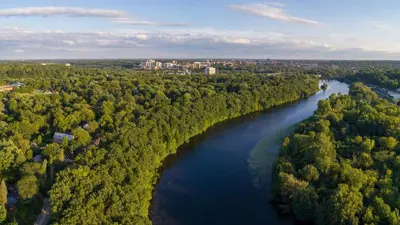Buildings in Ann Arbor account for over 60% of our total carbon dioxide emissions.
The City of Ann Arbor's Justice Center is a five-story, 103,000 square-foot, $47.4 million project that opened in 2011. The building provides space for the 15th District Court, Ann Arbor Police operations, and the city's Information Technology unit.
Key LEED (Leadership in Energy and Environmental Design) GOLD building components
The high-performance building "envelope" has walls, windows and roofing designed to keep the cold and heat outside while maintaining comfortable interior temperatures.
The specially-engineered window glass and walkway overhangs provide shade from the hot summer sun when the sun is high in the sky. During the winter months, heating costs are reduced because the solar warmth is able to filter through the ceramic-banded glass walls when the sun is lower in the sky.
Natural day-lighting is optimized throughout the building by using occupancy sensors. High-efficiency task lighting lamps provide illumination only where and when needed.
Water conservation is supported through the use of low-flow fixtures and rooftop solar water heaters.
Air quality is protected with natural ventilation and by the use of low-VOC construction materials and cleaning products.
Justice Center's exterior sign with GOLD LEED highlights (pdf)
Municipal Center Sustainable Site LEED GOLD Landscaping
The landscaping on over 49 percent of Ann Arbor's Municipal Center site can capture and hold nearly five inches of a single rainfall event. Keeping stormwater on-site helps reduce flooding and over-burdening the city's stormwater drains, which empties untreated water directly into the Huron River. The on-site capture of precipitation is possible by incorporating numerous rain gardens, bioswales, porous pavement walkways and parking lots, City A2 green roof, a 15,000-gallon cistern, and the planting of native species deep-rooted plants and trees that help hold water in the soil.
Much of the rain water that falls on-site is is temporarily stored in the porous underground soils and gravel and allowed to slowly infiltrate into the groundwater system. Some water is stored in tanks to feed the Dreiseitl fountain during the warm-weather months or is stored in the 16,000-gallon cistern, used to irrigate the E. Huron rain garden.
GOLD LEED Green Roof
During the warm weather months, people may visit the green roof area planted on the second-floor promenade level of Larcom City Hall.
There are 5,000 12x24x4-inch vegetative trays covering over 10,300 square feet of the promenade's total 18,000 square foot roof surface. The trays are planted with a variety of sedum plants, scattered with alium (wild onion) for color and height.
Each plant tray contains 3 inches of engineered soil--a porous growing medium that can hold at least an inch of rain water per storm event and can hold over 6,000 gallons of water over the entire roof. Additional rain water flows over the the trays and trickles between the edges of the pavers, which are suspended a half-inch above the surface of the roof. This water is routed to the Municipal Center rain gardens.
The green roof includes 6-inches of concrete and a minimum 6 inches of foam insulation sandwiched between two layers of 1/16th inch (TPO) sealed rubber roofing membranes. A green roof costs about twice as much as a standard commercial roof, but is designed to last 2-3 times longer and can save on heating a cooling costs inside the building through the extra insulation.
Fun Facts
The Great Lakes hold 84 percent of North America's (and 21 percent of the world's) fresh water stored in surface water lakes and rivers.
Can you name all five Great Lakes? Hint--remember "HOMES" for Lakes Huron, Ontario, Michigan, Erie, and Superior.
The Larcom green roof was designed by Quinn Evans Architects and installed by CEI, based in Howell. The plant trays are designed by Live Roof and the plants came from a nursery in Spring Lake, Michigan.

